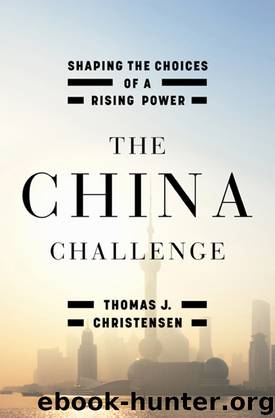The China Challenge by Thomas J. Christensen

Author:Thomas J. Christensen
Language: eng
Format: epub, mobi
Publisher: W. W. Norton & Company
The First North Korean Nuclear Crisis
ONLY ONE YEAR after acceding to the NPT, China would be put to the test by North Korea, its longtime ally. The 1993–1994 crisis began when North Korea was accused of prevaricating about the civilian nature of its activities at the Yongbyon nuclear facility. IAEA inspectors using methods unknown to the North Koreans discovered evidence that the nuclear facility was reprocessing spent fuel rods into fissile material for nuclear weapons. The Clinton administration entertained preemptive strikes, and the United States, South Korea, and like-minded states condemned North Korea. A resolution by the IAEA Board of Governors and a presidential statement at the UN Security Council in spring 1994 were met with belligerent threats by Pyongyang, including a threat to leave the NPT permanently and a warning that Seoul might be turned into a “sea of fire.”14
Former president Jimmy Carter helped defuse this serious and often underappreciated crisis in June 1994 with an independent visit to Pyongyang. Over the next several months, Pyongyang negotiated a freeze in reprocessing activities in exchange for energy assistance, including the construction of a light water nuclear reactor for the production of electricity. The Agreed Framework, signed in October 1994, effectively ended the first North Korean nuclear crisis, but it left many questions unsettled: What had become of the plutonium that the IAEA knew North Korea had already reprocessed? Would North Korea pursue highly enriched uranium as an alternative fissile material? And would the new leadership under Kim Jong-il honor the process started by his father, who passed away suddenly the month after Carter’s visit?
Although PRC–North Korean relations were at the time strained, as the PRC had infuriated Pyongyang by recognizing the Republic of Korea (South Korea) for the first time in 1992, U.S. diplomats were realistic and even pessimistic about what they could expect from China in terms of coordinated pressure. Given its history of opposition to sanctions, its rather reluctant accession to the Nuclear Nonproliferation Treaty just two years earlier, and its traditionally tight relationship with North Korea, China was hardly eager to join the United States and others in publicly condemning Pyongyang. From March to May 1994, China worked hard behind the scenes to water down the diplomatic language of the IAEA Board of Governors and the UN Security Council. Beijing’s goal was to prevent discussion of current or future sanctions against North Korea, to which, Beijing feared, Pyongyang might react in a destabilizing or even violent manner. So China ensured the removal of threats of “further Security Council action” if North Korea were to remain intransigent about its obligations as an NPT signatory.15
The chief U.S. negotiator, Robert Gallucci, and his team reported in retrospect that they were relieved and even surprised that China did not veto altogether the resolutions targeting North Korea that were passed by the IAEA Board of Governors in March 1994 and the Security Council two months later. Instead, Beijing abstained when the diluted resolutions came to a vote. China apparently promised the Americans privately to abstain so long as the resolution was “limited.
Download
This site does not store any files on its server. We only index and link to content provided by other sites. Please contact the content providers to delete copyright contents if any and email us, we'll remove relevant links or contents immediately.
| Arms Control | Diplomacy |
| Security | Trades & Tariffs |
| Treaties | African |
| Asian | Australian & Oceanian |
| Canadian | Caribbean & Latin American |
| European | Middle Eastern |
| Russian & Former Soviet Union |
The Secret History by Donna Tartt(18951)
The Social Justice Warrior Handbook by Lisa De Pasquale(12170)
Thirteen Reasons Why by Jay Asher(8849)
This Is How You Lose Her by Junot Diaz(6837)
Weapons of Math Destruction by Cathy O'Neil(6220)
Zero to One by Peter Thiel(5736)
Beartown by Fredrik Backman(5682)
The Myth of the Strong Leader by Archie Brown(5463)
The Fire Next Time by James Baldwin(5386)
How Democracies Die by Steven Levitsky & Daniel Ziblatt(5175)
Promise Me, Dad by Joe Biden(5117)
Stone's Rules by Roger Stone(5053)
A Higher Loyalty: Truth, Lies, and Leadership by James Comey(4909)
100 Deadly Skills by Clint Emerson(4882)
Rise and Kill First by Ronen Bergman(4741)
Secrecy World by Jake Bernstein(4703)
The David Icke Guide to the Global Conspiracy (and how to end it) by David Icke(4658)
The Farm by Tom Rob Smith(4468)
The Doomsday Machine by Daniel Ellsberg(4452)
